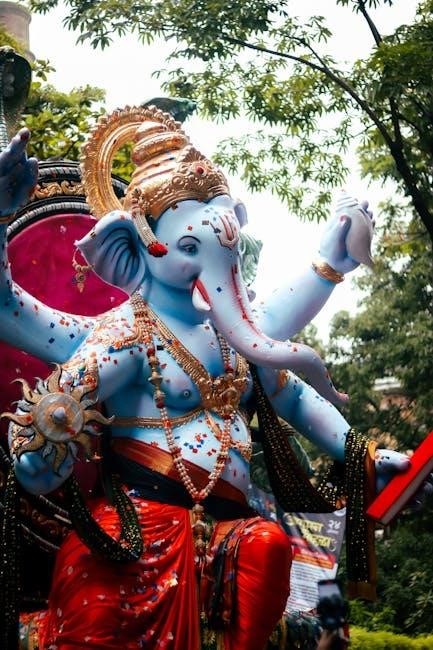
vinayaka chavithi katha telugu pdf
Vinayaka Chavithi Katha is a sacred narrative central to the festival, detailing Lord Ganesha’s birth and Parvati’s divine intervention․ It holds cultural and spiritual significance, guiding devotees through rituals and practices․ The Telugu PDF serves as a comprehensive guide for those observing the festival․
1․1․ Overview of Vinayaka Chavithi
Vinayaka Chavithi, also known as Ganesh Chaturthi, is a significant festival in Telugu culture, celebrating Lord Ganesha’s birth․ It is observed with great fervor in Andhra Pradesh and Telangana, typically spanning 11 days․ Devotees perform elaborate pooja rituals, fast, and recite the sacred Vinayaka Chavithi Katha, which narrates Ganesha’s divine origin․ The festival begins on Bhadrapada Shuddha Chaviti and includes traditional practices like Akshata placement and Chandra Darshan․ Resources like the Telugu PDF provide detailed guidance on Pooja Vidhanam, Vratha Kalpam, and the Katha, ensuring devotees follow rituals accurately․ This festival symbolizes the triumph of good over evil and seeks blessings for prosperity and wisdom․
1․2․ Significance of Vinayaka Chavithi Katha
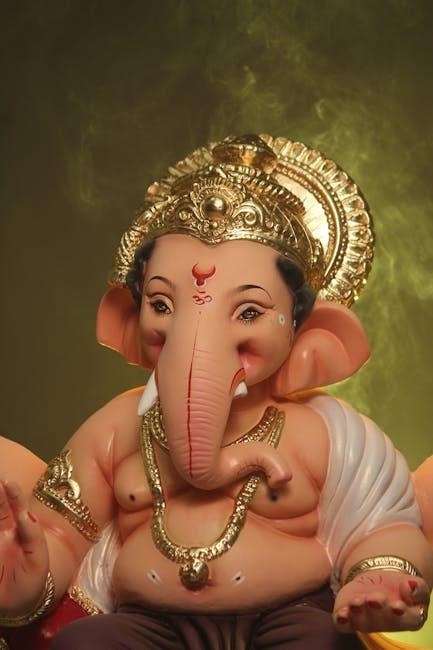
The Vinayaka Chavithi Katha holds profound spiritual significance, as it narrates the divine story of Lord Ganesha’s birth and his role as a remover of obstacles․ The Katha is an integral part of the festival, offering devotees spiritual enlightenment and a deeper connection to the deity․ It is believed that reciting the Katha brings blessings, prosperity, and wisdom; The story also emphasizes the importance of devotion and faith, highlighting Parvati’s determination and Ganesha’s divine intervention․ By listening to the Katha, devotees seek to overcome challenges and attain spiritual growth, making it a cornerstone of the festival’s rituals and traditions․
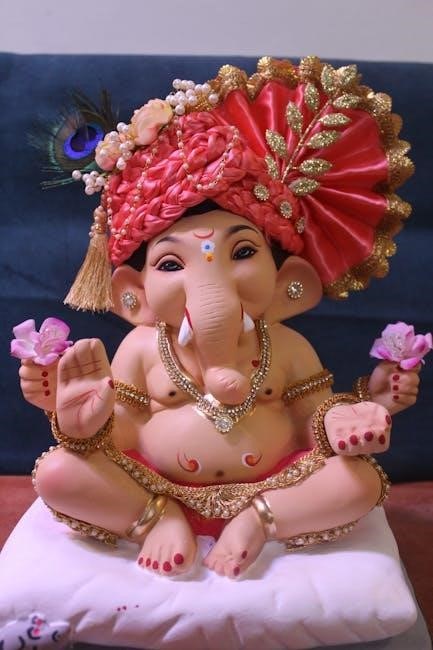
Historical Background of Vinayaka Chavithi
Vinayaka Chavithi traces its origins to ancient Hindu mythology, centered around the legend of Gajasura and the divine intervention of Lord Vishnu to free Shiva, leading to Ganesha’s emergence․
2․1․ The Legend of Gajasura
Gajasura, an asura with an elephant-like form, performed intense tapasya to appease Lord Shiva․ Pleased with his devotion, Shiva granted him a boon․ Gajasura requested Shiva to reside within his stomach, which Shiva, known for his kindness to devotees, accepted․ This led to Shiva being confined, causing distress among the gods and Parvati, who later sought Vishnu’s help to free her husband․ This legend is central to the narrative of Vinayaka Chavithi Katha, highlighting the divine interventions and the eventual emergence of Lord Ganesha․
2․2․ The Birth of Lord Ganesha
Lord Ganesha’s birth is a divine tale of creation and sacrifice․ Goddess Parvati, while residing in Kailasa, fashioned Ganesha from clay to serve as her guardian during Shiva’s absence․ She bestowed life into the clay figure, instructing him to guard the entrance and deny entry to anyone․ When Shiva returned, Ganesha, unaware of his identity, refused him entry, leading to a fierce battle․ Shiva, in his divine fury, beheaded Ganesha․ Parvati, grief-stricken, threatened cosmic destruction, prompting the gods to revive Ganesha by attaching an elephant’s head․ This myth symbolizes Ganesha’s role as the remover of obstacles and his divine origin, central to Vinayaka Chavithi Katha․
2․3․ Parvati’s Role in Ganesha’s Story
Goddess Parvati plays a pivotal role in the narrative of Lord Ganesha․ She created Ganesha from clay to protect herself during Shiva’s absence, instilling in him unwavering loyalty․ When Shiva beheaded Ganesha, Parvati’s grief and anger threatened cosmic balance, compelling the gods to intervene․ Her maternal love and determination led to Ganesha’s resurrection with an elephant’s head, solidifying his divine status․ Parvati’s actions underscore her strength and devotion, making her a central figure in the Vinayaka Chavithi Katha, symbolizing the power of maternal love and divine intervention․
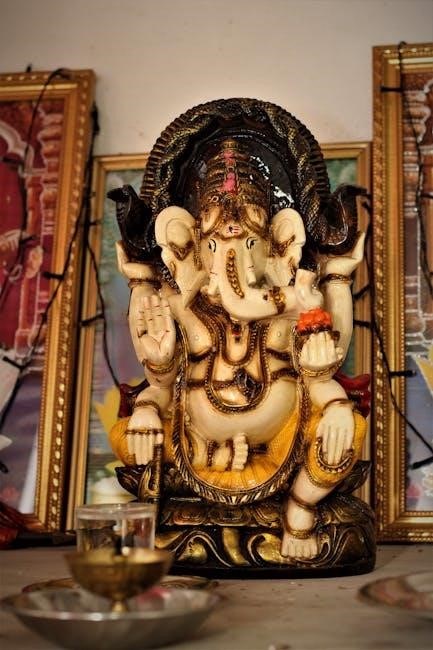
The Story of Vinayaka Chavithi Katha
The narrative revolves around the legend of Gajasura, Parvati’s quest to free Shiva, and Vishnu’s intervention, culminating in Ganesha’s emergence as the remover of obstacles, as detailed in the Telugu PDF․
3․1․ The Tale of Gajasura and Shiva
Gajasura, an evil ruler with an elephant-like form, performed intense tapasya to please Lord Shiva․ Shiva, satisfied with his devotion, granted him a boon․ Gajasura requested Shiva to reside within his stomach, believing it would grant him immense power and protection․ Shiva, known for his kindness towards devotees, agreed and stayed inside Gajasura․ This act led to a significant chain of events, including Parvati’s distress upon her husband’s disappearance and the eventual intervention of other deities to free Shiva․ This tale forms a crucial part of the Vinayaka Chavithi Katha, as detailed in the Telugu PDF․
3․2․ Parvati’s Quest to Free Shiva
Parvati, the consort of Shiva, grew deeply distressed upon discovering her husband’s absence․ She learned that Shiva was confined within the stomach of the demon Gajasura․ Determined to free him, Parvati sought the assistance of Lord Vishnu, who devised a plan to liberate Shiva․ Vishnu, along with other deities like Indra and Brahma, disguised themselves as musicians and approached Gajasura’s kingdom․ Their divine music mesmerized Gajasura, leading to his eventual demise․ This narrative highlights Parvati’s devotion and the collaborative effort of the gods to restore balance․ The Telugu PDF elaborates on this pivotal moment in the Vinayaka Chavithi Katha․
3․3․ The Intervention of Lord Vishnu
Lord Vishnu played a pivotal role in freeing Shiva from Gajasura’s captivity․ Upon Parvati’s plea, Vishnu devised a strategic plan involving the gods․ Disguised as musicians, they entered Gajasura’s kingdom, captivating him with enchanting melodies․ This diversion led to Gajasura’s demise, allowing Shiva’s release․ Vishnu’s intervention showcased his wisdom and divine power, facilitating the events that culminated in Ganesha’s emergence․ The Telugu PDF details this narrative, emphasizing Vishnu’s crucial role in restoring cosmic harmony and enabling Parvati to create Ganesha, who would become the remover of obstacles․
3․4․ The Emergence of Lord Ganesha
Following Shiva’s release, Parvati’s grief over Ganesha’s beheading moved Shiva to revive their son․ He dispatched his attendants to fetch the head of the first living being they encountered—an elephant․ Attaching the elephant’s head to Ganesha’s body, Shiva breathed life into him․ This divine intervention marked Ganesha’s emergence as the remover of obstacles․ The Telugu PDF elaborates on this miraculous event, highlighting Parvati’s maternal love and Shiva’s divine power․ Ganesha’s unique form symbolizes adaptability and divine grace, making him a revered deity in Hindu culture, celebrated during Vinayaka Chavithi for his benevolent presence in devotees’ lives․
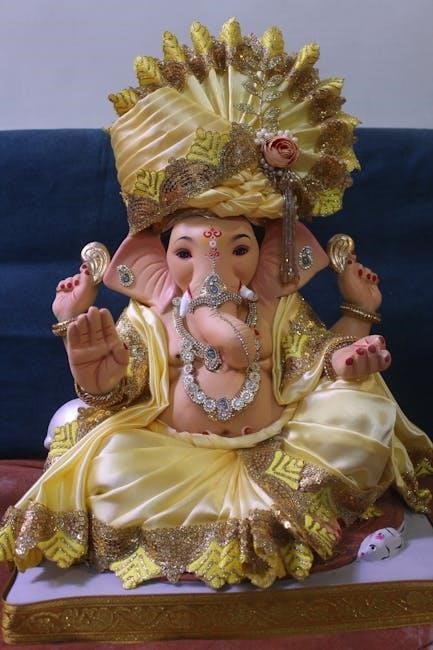
Pooja Vidhanam (Worship Procedure)
Pooja Vidhanam outlines the detailed worship procedure for Vinayaka Chavithi, emphasizing rituals, item preparation, and prayer sequences․ The Telugu PDF guides devotees through each step, ensuring authenticity and spiritual fulfillment․
4․1․ Essential Items for Pooja
The pooja requires specific items to ensure its sanctity and completeness․ A clay idol of Lord Ganesha is central, along with flowers, coconuts, and traditional offerings․ Akshatas (sacred rice grains) are sprinkled during rituals, while modaks (sweet dumplings) are offered as prasadam․ Other essentials include turmeric, vermilion, sandalwood paste, and a deepa (oil lamp) for illumination․ The Telugu PDF provides a detailed list, ensuring devotees prepare thoroughly for the worship, highlighting the significance of each item in invoking divine blessings and maintaining ritual purity․ These items symbolize devotion and facilitate a spiritually fulfilling pooja experience․
4․2․ Step-by-Step Pooja Process
The pooja begins with cleansing the area and setting up the idol of Lord Ganesha․ Devotees perform a series of rituals, starting with shodashopachara, which includes 16 offerings like flowers, fruits, and sandalwood paste․ Following this, the maha abhishekam is performed, where the idol is bathed with sacred items․ Mantras and hymns are chanted to invoke divine blessings․ The pooja concludes with the distribution of prasadam and the circumambulation of the idol․ The Telugu PDF guides devotees through these steps, ensuring adherence to tradition and spiritual significance, making the worship both meaningful and reverent․ Each step is designed to deepen the connection with Lord Ganesha․
4․3․ Importance of Pooja Vidhanam
The Pooja Vidhanam holds immense significance as it ensures the rituals are performed correctly, invoking divine blessings․ It serves as a guide, helping devotees maintain tradition and spiritual authenticity․ The structured process fosters a deeper connection with Lord Ganesha, promoting harmony and prosperity․ By following the Vidhanam, devotees demonstrate reverence and commitment, enhancing the festival’s spiritual impact․ The Telugu PDF provides detailed instructions, making it accessible for all to perform the pooja with devotion and precision․ Adhering to the Vidhanam is believed to bring fulfillment of desires and spiritual growth, emphasizing its vital role in the celebrations․ It is a cornerstone of Vinayaka Chavithi traditions․

Vratha Kalpam (Fasting Rituals)
Vratha Kalpam involves rigorous fasting rituals, observed by devotees to seek divine blessings․ It emphasizes spiritual purification and devotion, adhering to traditional practices outlined in the Telugu PDF guide․ This fasting period is believed to strengthen faith and bring prosperity, while the detailed rituals enhance the sacred experience of Vinayaka Chavithi, fostering a deeper connection with Lord Ganesha․ The strict adherence to these rituals is considered essential for fulfilling desires and achieving spiritual harmony․ The guide provides comprehensive instructions, ensuring devotees perform the rituals with precision and devotion, making the fasting period both meaningful and rewarding; It is a vital aspect of the festival, reflecting the rich cultural and religious heritage of the Telugu community․ The rituals are designed to promote self-discipline and mindfulness, while the act of fasting is seen as a form of worship, pleasing Lord Ganesha and seeking his grace․ By following the Vratha Kalpam, devotees aim to attain both spiritual and material benefits, ensuring a balanced and fulfilling life․ The importance of these rituals is further emphasized through their traditional significance and the role they play in maintaining the festival’s authenticity․ Overall, Vratha Kalpam is a cornerstone of Vinayaka Chavithi celebrations, guiding devotees toward a path of righteousness and divine connection․
The fasting rituals during Vinayaka Chavithi, as detailed in the Telugu PDF, involve strict observance of abstinence from certain foods and activities․ Devotees typically abstain from consuming non-vegetarian dishes and alcohol, adhering to a sattvic diet to purify the mind and body․ The fasting period begins early in the morning and concludes after the evening puja, with devotees often surviving on fruits, nuts, and other fasting-specific foods․ The rituals emphasize mental discipline and devotion, encouraging participants to focus on spiritual growth․ The PDF guide provides detailed instructions on the proper way to observe the fast, ensuring that devotees can perform the rituals with precision and dedication, thus maximizing the spiritual benefits of the fasting period․ Chandra Darshan, or the sighting of the moon, holds immense significance during Vinayaka Chavithi․ According to the Telugu PDF, it is believed that viewing the moon after sunset on this day can lead to Chandra Dosha, a celestial inauspiciousness․ To avoid this, devotees are advised to perform pradakhina (circumambulation) around Lord Ganesha and place akshatas (sacred grains) on their heads․ This ritual is said to ward off negative energies and ensure blessings․ The PDF emphasizes the importance of adhering to this tradition to maintain the purity and efficacy of the festival․ By following these guidelines, devotees can align their practices with ancient customs and seek divine grace․ Akshatas, or sacred rice grains, play a pivotal role in Vinayaka Chavithi rituals․ According to the Telugu PDF, these grains are offered to Lord Ganesha during worship and later distributed among devotees․ Placing akshatas on the head after hearing the katha and performing pradakhina is believed to ward off negative energies and prevent Chandra Dosha․ The grains symbolize purity and prosperity, ensuring the rituals’ efficacy․ Their use is a cherished tradition, deeply rooted in the festival’s cultural and spiritual practices, and is essential for seeking divine blessings and maintaining harmony during the celebrations․ Vinayaka Chavithi Katha is a spiritual narrative essential to the festival, recounting Lord Ganesha’s divine story․ Its recitation is a sacred ritual, offering devotees spiritual enlightenment and divine grace․ Vinayaka Chavithi Katha narrates the divine origin of Lord Ganesha, emphasizing his role as a remover of obstacles․ The story begins with Parvati creating Ganesha from clay to guard her while bathing․ When Lord Shiva, unaware of Ganesha’s identity, beheads him, Parvati’s grief moves Shiva to revive Ganesha with an elephant’s head․ This tale underscores Ganesha’s divine purpose and maternal love․ The Telugu PDF version of this katha is widely revered, guiding devotees through rituals and fostering spiritual connection, ensuring prosperity and blessings from Lord Ganesha․ Reciting Vinayaka Chavithi Katha is believed to bring immense spiritual and material benefits․ It is said to grant wisdom, prosperity, and the removal of obstacles in life․ Devotees who recite the katha with devotion are blessed with Lord Ganesha’s grace, ensuring success in endeavors and harmony in relationships․ The act of recitation also strengthens faith and purifies the mind, fostering a deeper connection with the divine․ Additionally, it is believed to mitigate negative influences and bring good fortune․ The Telugu PDF version of the katha serves as a handy guide, enabling devotees to perform the recitation accurately and reap its sacred benefits․ Devotees play a crucial role in the recitation of Vinayaka Chavithi Katha, as their active participation is essential for its spiritual significance․ They are expected to recite the katha with utmost devotion, following the rituals and guidelines outlined in the Telugu PDF․ The recitation not only strengthens their faith but also fosters a deeper connection with Lord Ganesha․ Devotees are encouraged to listen attentively and perform the prescribed rituals, such as placing akshatas on their heads after recitation․ This collective effort enhances the spiritual ambiance and reinforces the belief in the divine blessings of Lord Ganesha․ The involvement of devotees is vital for the katha to fulfill its purpose of spiritual growth and communal harmony․ Vinayaka Chavithi requires specific items like betel leaves, turmeric, vermilion, coconuts, and modaks․ These offerings symbolize purity, prosperity, and devotion, enhancing the spiritual significance of the rituals․ The essential items for Vinayaka Chavithi Pooja include betel leaves, betel nuts, turmeric powder, vermilion, coconut, flowers, modaks (sweet dumplings), uncooked rice, grains, ghee, oil lamp, incense sticks, akshatas (sacred rice), and beads․ These items hold spiritual significance and are used to invoke divine blessings․ The coconut symbolizes fertility, while modaks represent Lord Ganesha’s favorite food․ Akshatas are sprinkled on the head to ward off negative energies․ Each offering is carefully prepared and presented with devotion, ensuring the rituals are performed with purity and grace․ Traditional offerings to Lord Ganesha include modaks (sweet dumplings), fruits like bananas and coconuts, and flowers such as hibiscus and marigold․ These offerings symbolize devotion and seek blessings for prosperity․ Betel leaves and nuts are also offered, representing purity and longevity․ The offerings are placed before the deity with chants and prayers, creating a sacred atmosphere․ These traditional items are believed to please Ganesha, ensuring his grace and protection․ The act of offering is a vital part of the pooja, fostering a deep connection between the devotee and the divine․ Each offering to Lord Ganesha holds profound symbolic meaning․ Modaks, his favorite sweet, represent the triumph of wisdom over ignorance․ Fruits like bananas and coconuts symbolize purity and the fulfillment of desires․ Flowers such as marigold and hibiscus signify devotion and positivity․ Betel leaves and nuts, known as tamboolam, embody longevity and prosperity․ These offerings are believed to appease Ganesha, ensuring his blessings for success, health, and happiness․ The ritual of offering these items strengthens the spiritual bond between the devotee and the deity, reflecting faith and gratitude․ Vinayaka Chavithi is a cherished festival in Andhra Pradesh and Telangana, symbolizing cultural unity and devotion․ It honors Lord Ganesha, seeking his blessings for prosperity and obstacle removal․ Vinayaka Chavithi holds immense cultural and religious significance in Telugu-speaking regions, particularly in Andhra Pradesh and Telangana․ It is celebrated with great fervor, marking the birth of Lord Ganesha․ Traditional rituals, including the recitation of Vinayaka Chavithi Katha, are integral to the festivities․ Families prepare elaborate pujas, offering modaks and other sweets to Ganesha․ The festival strengthens family bonds and reinforces cultural heritage․ Community celebrations, processions, and decorations add to the festive atmosphere, making it a vibrant part of Telugu tradition․ The Telugu PDF guides devotees in performing rituals and understanding the story’s cultural importance․ Vinayaka Chavithi is deeply rooted in Hindu religious traditions, honoring Lord Ganesha as the remover of obstacles․ The festival is observed with fasting, puja, and recitation of the Vinayaka Chavithi Katha, which narrates Ganesha’s divine birth and Parvati’s devotion․ It emphasizes spiritual cleansing and seeking Ganesha’s blessings for prosperity․ The rituals, detailed in the Telugu PDF, highlight the importance of devotion and faith․ The festival is a time for introspection, renewal, and connecting with the divine, reinforcing Ganesha’s role as a protector and guide in Hinduism․ Its religious significance is profound, making it a vital observance for devotees seeking spiritual growth and divine grace․ Vinayaka Chavithi is celebrated with great fervor in Andhra Pradesh and Telangana․ The festival is marked by elaborate rituals, processions, and cultural events․ Devotees decorate homes and public spaces with vibrant decorations, while traditional dishes like modak and sundal are prepared․ Communities organize grand processions, often accompanied by traditional music and dance․ Temples dedicated to Lord Ganesha are adorned with flowers and lights, attracting thousands of devotees․ Families gather to perform Vinayaka Chavithi Katha recitations and pujas, following the guidelines outlined in the Telugu PDF․ The festival fosters unity and joy, reflecting the rich cultural heritage of the Telugu states․ Modern celebrations incorporate technology, with digital resources like PDFs and apps guiding rituals․ Eco-friendly idols and online pujas are gaining popularity, blending tradition with convenience and sustainability seamlessly․ Digital platforms now offer Telugu PDFs of Vinayaka Chavithi Katha, providing detailed pooja vidhanam, vrat katha, and required items․ These resources are easily accessible, enabling devotees to perform rituals with precision and devotion․ Apps and websites further enhance the experience, offering step-by-step guides, audio recitations, and video tutorials․ This modern approach ensures that traditions remain intact while catering to the convenience of contemporary lifestyles․ Devotees can download these materials to effortlessly follow the pooja process, making the festival more accessible and user-friendly for all․ Vinayaka Chavithi is widely celebrated in Telugu communities with grandeur and devotion․ Public pandals are erected, showcasing gigantic Ganesha idols, adorned with vibrant decorations․ Cultural programs, traditional dances, and musical performances are organized, drawing large crowds․ Community members gather for collective pooja ceremonies, fostering unity and spiritual connection․ In places like Tirupati, the festival is marked with processions and offerings to Lord Ganesha․ These celebrations not only strengthen cultural bonds but also provide a platform for sharing the sacred Vinayaka Chavithi Katha among generations, ensuring its legacy endures․ The collective energy and joy of these events make the festival a memorable experience for all participants․ Technology has revolutionized the way devotees observe Vinayaka Chavithi․ Digital platforms now offer downloadable Telugu PDFs of Vinayaka Chavithi Katha, enabling easy access to rituals and stories․ Online portals provide detailed pooja vidhanam, while apps guide devotees through step-by-step procedures․ Live-streamed pujas allow global participation, especially for those unable to attend in person․ Social media platforms foster community engagement, sharing festival preparations and cultural exchanges․ Technology also aids in distributing akshatas and prasadam virtually, ensuring inclusivity․ This integration of tradition with modern tools enhances accessibility, making the festival more convenient and widespread while preserving its spiritual essence and cultural heritage for future generations․ Observing Vinayaka Chavithi brings spiritual growth, material prosperity, and the blessings of Lord Ganesha․ It helps overcome obstacles and fosters a harmonious life, fulfilling heartfelt desires devoutly․ Observing Vinayaka Chavithi offers profound spiritual benefits, including inner peace and a stronger connection to the divine․ The festival helps cleanse the mind of negativity, fostering a sense of purity and devotion․ By reciting the Vinayaka Chavithi Katha and performing rituals, devotees seek blessings for wisdom, prosperity, and the removal of obstacles․ The spiritual practices during this period enhance self-reflection and renewal, aligning one’s actions with divine will․ Faith and sincere prayer during the festival are believed to strengthen spiritual growth, guiding individuals toward a harmonious and purposeful life under Lord Ganesha’s grace․ The festival is a powerful occasion for spiritual enrichment and renewal․ Devotees believe that observing Vinayaka Chavithi brings tangible material benefits, such as increased prosperity, wealth, and success in endeavors; The festival is thought to attract positive energies, enhancing career growth and financial stability․ By reciting the Vinayaka Chavithi Katha and performing rituals, devotees seek blessings for overcoming obstacles and achieving their goals․ The festival is also associated with improved health and longevity, as Lord Ganesha is revered as the remover of difficulties․ Many believe that sincere prayers during this period result in favorable outcomes, ensuring a better quality of life and fulfilling desires․ The material benefits are often seen as divine rewards for devotion and faith․ Lord Ganesha is revered as the remover of obstacles and the granter of wisdom and prosperity․ Devotees believe that observing Vinayaka Chavithi with sincerity invites His blessings, ensuring success in endeavors and personal growth․ The recitation of Vinayaka Chavithi Katha is said to bring divine grace, protecting one from misfortunes and fostering harmony in life․ Many seek His blessings for academic excellence, career advancement, and marital bliss․ Ganesha’s benevolence is also believed to grant strength during challenging times, making Him a beloved deity in Hindu culture․ His blessings are considered a cornerstone of happiness and fulfillment, guiding devotees toward a path of righteousness and prosperity․ Vinayaka Chavithi Katha embodies the cultural and religious essence of the festival, guiding devotees through rituals and fostering devotion․ Its significance lies in its ability to connect faith with tradition, ensuring divine blessings․ Vinayaka Chavithi stands as a testament to faith, tradition, and cultural heritage, embodying the essence of devotion to Lord Ganesha․ The festival’s rituals, stories, and offerings create a profound spiritual experience, fostering unity and blessings․ The Telugu PDF guide serves as a vital resource, preserving the legacy of the festival․ It is a celebration that transcends generations, connecting devotees to their roots and reinforcing the belief in divine grace․ Through its rich traditions, Vinayaka Chavithi continues to inspire and uplift, ensuring its relevance in modern times while honoring its ancient origins․ Vinayaka Chavithi remains a timeless celebration, deeply rooted in tradition and spirituality․ Its legacy endures through generations, preserving the essence of faith and cultural heritage․ The festival’s rituals, stories, and offerings continue to inspire devotion, fostering a sense of community and shared identity․ The Telugu PDF resources ensure that the traditions and narratives are accessible to all, maintaining the festival’s relevance in modern times․ By honoring Lord Ganesha and adhering to ancient customs, devotees keep the legacy alive, ensuring its continuation for future generations․ This festival is not just a celebration but a living testament to the power of faith and tradition․5․1․ The Rituals of Fasting
5․2․ The Significance of Chandra Darshan
5․3․ The Role of Akshatas
The Katha and Its Recitation
6;1․ The Story of Vinayaka Chavithi Katha
6․2․ Benefits of Reciting the Katha
6․3․ The Role of Devotees in Katha Recitation
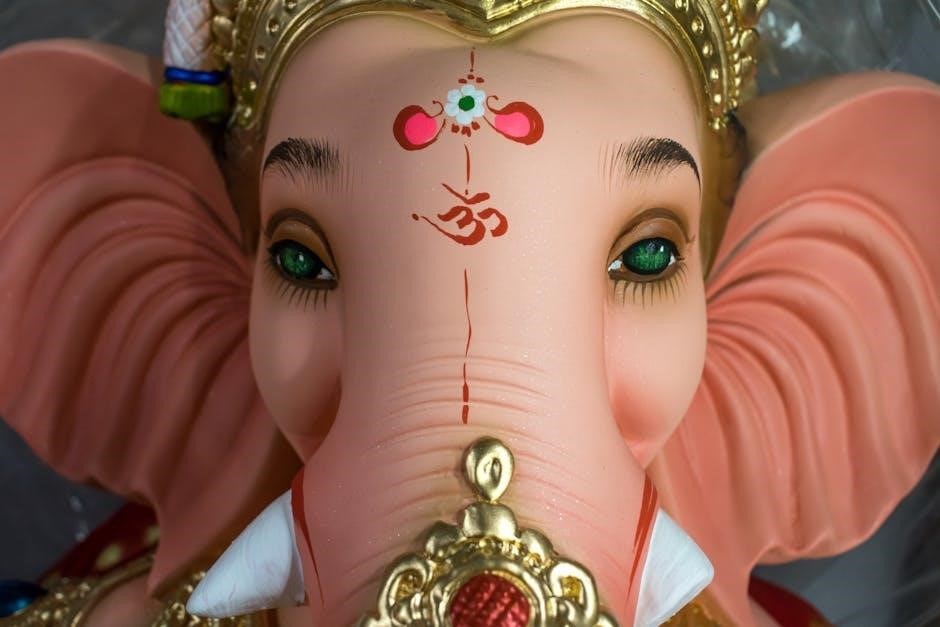
Pooja Items and Offerings
7․1․ List of Required Pooja Items
7․2․ Traditional Offerings to Ganesha
7․3․ The Significance of Each Offering
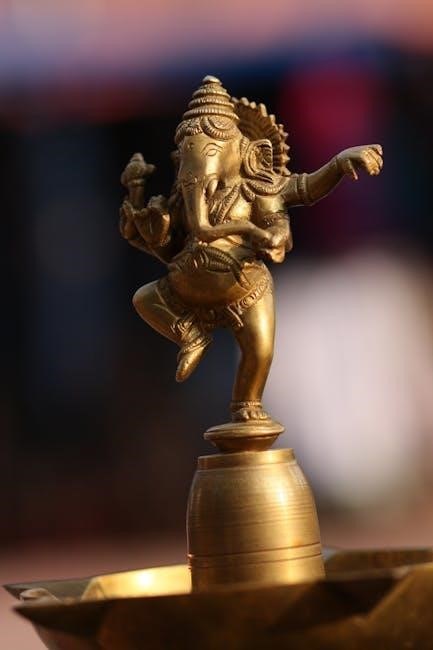
Cultural and Religious Significance
8․1․ Vinayaka Chavithi in Telugu Culture
8․2․ The Festival’s Religious Importance
8․3․ Celebrations Across Telugu States
Modern Celebrations and Practices
9․1․ Digital Resources for Pooja
9․2․ Community Celebrations
9․3․ The Role of Technology in Pooja
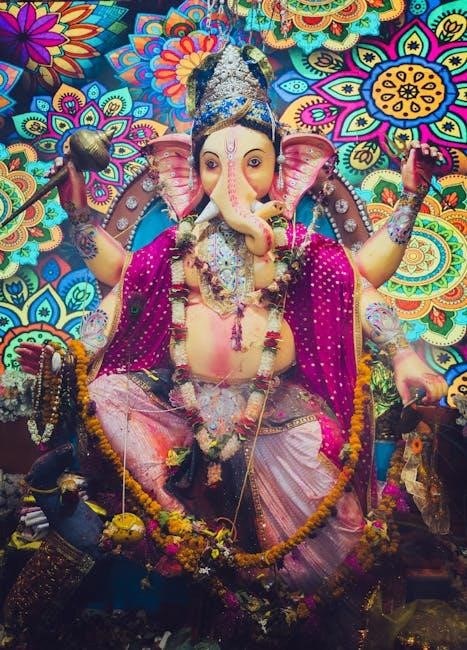
Benefits of Observing Vinayaka Chavithi
10․1․ Spiritual Benefits
10․2․ Material Benefits
10․3․ The Blessings of Lord Ganesha
11․1․ Final Thoughts on Vinayaka Chavithi
11․2․ The Enduring Legacy of the Festival